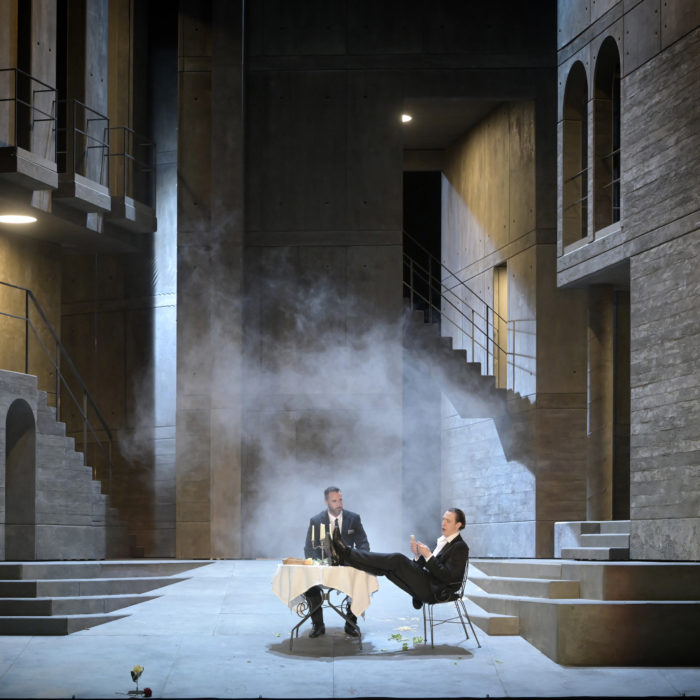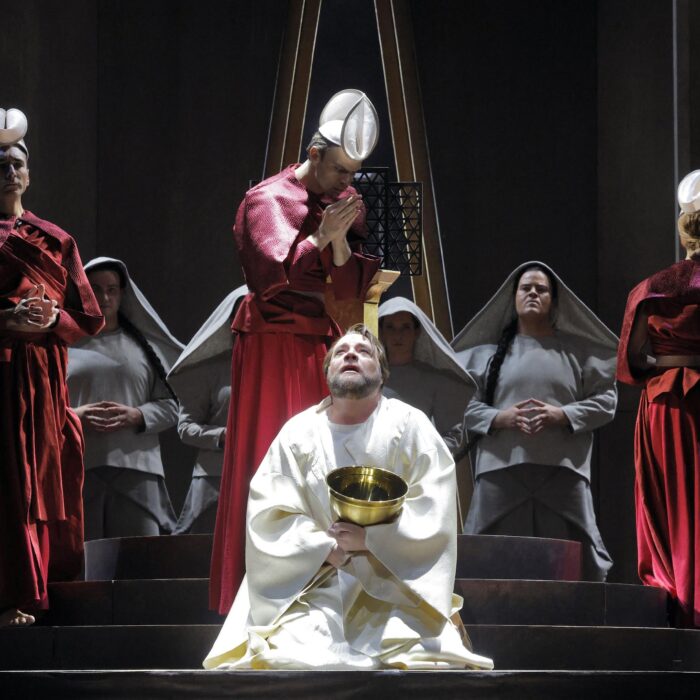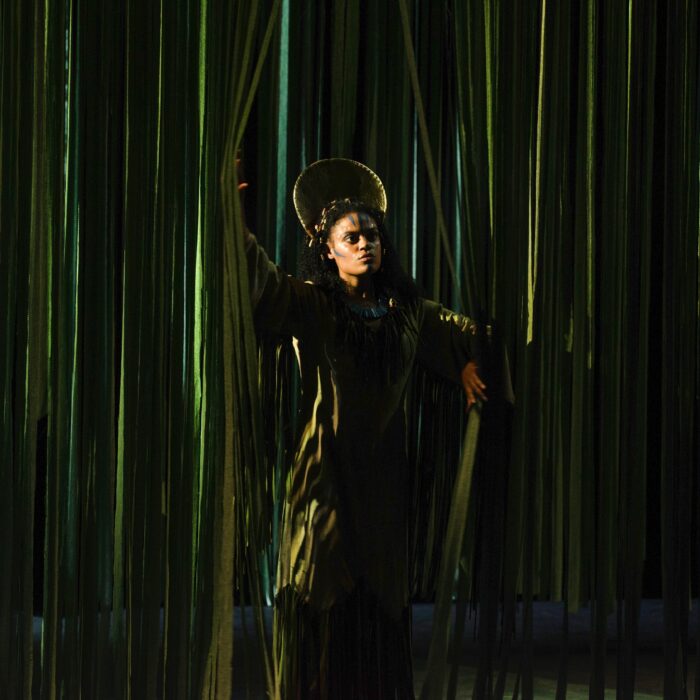
Bayreuth Festival 2025 Review: Tristan und Isolde
By Vincent Lombardo(Credit: Enrico Nawrath)
“They enter into blinding darkness those who worship chaos;
into greater darkness still those who delight in shadow.”
Upanishad, Verse IX
Coming to Wagner’s “Tristan und Isolde” for the first time must always remain a unique, emotional, musical experience. It is an opera of subtle interpretations, not only regarding the music and dramatic action, but perhaps more for a libretto dense with ambiguities. It is, at its base, a rather simple story immersed in myth, yet one in which all the characters find themselves in predicaments as victims, requiring them to face crises arising from the depths of their own unknown selves. Many sung words carry a double meaning, challenging the present with what remains unresolved in the past. Wagner’s choice of annotations in the score, itself worthy of deeper study, refer not only to musical nuance, but to the truths of existence that he is seeking to uncover within his own eternal self.
Words Presage Music
Wagner sets all in motion right from the start. The dissonance within that famed diminished chord in the third measure, repeated thrice, swells from a reverent silence as marked “langsam und schmachtend, aber nicht schleppend,” which translates as “slow and languid, but not dragging.” Perhaps it also means “an unwillingness to act,” as if moving forward with difficulty, seemingly lethargic, enfeebled, yet hard-fought and weary with effort. Might this Prelude be the key to understanding the entire work? Perhaps we will come to sense the effect of these words upon the questioning reverberations of the piece – or even hear an echo, transmuted into our desire to seek a distant, ethereal world where human love is transcendent and attainable, forging a link between our waking selves and the realm of dreams and home of the spirit. The entire opera leads to Isolde’s “Liebestod,” her longing through “love-death,” an attempt to free herself from all bonds of earthly constraint so as to unite with her departed Tristan. Yet, before accomplishing this, one must overcome that crisis of late-Romantic sentiment through one’s removal from reality itself. Here we sense the dangers of entering into the darkness of the Second Act, immersed in that surreal, remote garden where daylight never falls. Here, we are to abandon an arduous world, love now refusing its own doubts, making us less complicated and prone to trusting through instinctive innocence. This is a Wagnerian theme found throughout his operas.
This may imply that “Tristan und Isolde” is Wagner’s most difficult opera to decipher, and as the drama progresses we may not be certain of the characters’ complicated motivations. But let us not assume that the composer’s dramatic instinct was to lead us to confusion or misconception. Simply put, his underlying creative drive derived from elusive spiritual and philosophical worlds. His missives, be they writings, libretti, or music, can only suggest that we should be aware of and explore the recesses of our own beliefs, steeped as they are in the unconscious.
The essence of the Celtic myth that formed the foundation for Wagner’s opera is shrouded not so much in mystery as in being laced with never-ending turns of circumstance and fate in which all are involved, or at least witnesses to. For the true opera lover, there is little concern regarding consequential action: it is the overall impact of music and theater combined that brings its own rewards. However, knowing Wagner’s works alone does not allow us to keep pace with all that unfolds upon the stage. Too much is going on musically, and only extended familiarity with his operas will allow us to sense the all-involving microcosms of human experience. What escapes us is the multifarious weaving of thoughts through music linked to other thoughts, at times not connected directly to any one dramatic moment. However, there are hints that serve as essential sentiments: those themes and leitmotifs which, when brought to us by the singers and musicians, bring the full impact of Wagner’s all-encompassing work.
Inner Restlessness
The First Act corresponds to this esoteric communication as Wagner lays out his musical thoughts in an intricate manner. Nothing is to be taken for granted. The somewhat unsettling Sailor’s song that initiates the drama should, at least to the observant ear, give hint to the inner restlessness within Isolde herself. Her first words are furiously emitted, demanding to know who is hinting at her unhappiness, to which three alternating sets of strings forcefully race up and down, mercilessly depicting a sort of agitation leitmotif. This is characteristic of the emotive exaggerations that could have us believe that even Wagner has been swept away. Isolde appears to have lost all bearings and thus must ask her handmaiden Brangäne where they are. Her answer is sung in part to the music of the sailor’s ditty, and the presence of a majestic sea takes ahold of us. The whole opera may be a metaphor for being adrift as Wagner again turns to the powerful mysteries of the sea. With this production’s somewhat minimalistic stance, we are asked to enter into a world astray from reality, only to be let down by the unenchanting ambiance surrounding a supposed ship upon high seas. Here we find loosely hanging ropes center stage to give the impression of a vessel’s rigging, and that is almost all we see. Other characters flitter about in the mist beyond that rigging until they break the fourth wall and come to the forefront of that other stage, the world of a kneeling Isolde, close to scattered objects behind her. She is absorbed, almost fanatically, in scribbling runes upon her voluminous, white, late Victorian gown. This object will become an obsessive crutch, a Linus blanket, as it journeys with her, is stepped upon, packed, unpacked, worn, even changing ownership. Finally, it is slept in, shroud-like, during Isolde’s “Liebestod” farewell, again offering security through a return to a protective fetal position. It also takes on a darker significance, and in later stages of the opera may be seen as a kind of prison, impeding her freedom. Though impressive at times to look at it – it has a diameter of over 20 feet – the dress also outlasts its purposefulness, and in the end can no longer stress the tragic elements associated with Isolde.
Early Romanticism
The Second and Third Acts, magnificent architectonic structures of light and sound, must allow the spectator to pass beyond a plethora of references and allusions and perceive clearly the differences between Day and Night. Wagner leans upon the tonal shadings of his musical language to close the distance between those two realms, and suggestion grasps at reality through mood, not ambiance. When it comes to Wagner, the presence of the singing-actor alone often bears the weight of convincing us of the entire opera’s validity. All other stagecraft must subtlety enhance the singing-actor. When props are used just to create movement, or worse, to make comment upon what has already been made clear, they become gratuitous. The error of stage director Thorleifur Örn Arnarsson is his apparent distrust of Wagner’s libretto and its poetic intent. We must remember the influences of Jena Romanticism upon Wagner, and especially Novalis’ six-poem cycle, “Hymns to the Night.” Its fourth poem, with its short, pungent, ecstatic outbursts could very well be a page from the “Tristan und Isolde” libretto. The gamut of Novalis’ expressions more than influenced Wagner, and we might imagine the transference of that poet’s words into Wagner’s libretto: “opening the doors to Heaven… stepping to meet them out of ancient stories, bearing the key to the dwellings of the blessed… the silent messenger of infinite secrets…” Novalis’ famed question haunted Wagner: “Why must the morning always return?” Indeed, those very same questions were posed by Wagner to Mathilde Wesendonck in his “Wesendonck Lieder,” dedicated to her, with music taken from the score of the then incomplete “Tristan und Isolde.” May we now justify Wagner’s textual excesses and repetitions as being all in the service of – as he always intended – such sublime music?
The two scenes of Act Two bring to the forefront the essence of this staging, vaunting movement for movement’s sake. Opera can sometimes create problems that theatrical representations do not: creating inner sentiments in opposition to the text will always lead us astray, perhaps even creating confusion. The first scene, played downstage in a spotlit area, is that of King Marke’s garden, and thus the ship’s riggings have been pulled up into the wings. A worried Isolde marches back and forth in agitation – yet she should be calm, as she is sure that the King is away hunting and she is free to meet Tristan. We are encouraged to ask if Isolde is still under the influence of the love elixir, or if she is desperately reliving her past traumas. The hunting horns do seem far away, yet Brangäne hears them nearby and warns of the King’s imminent return. Isolde responds, “Anxious fear deceives your ear… you are deluded by the rustle of leaves that the wind shakes.” The chorus of horns should take center stage, and we should be able to interpret clearly the differences in Isolde and Brangäne perceptions of the fanfare. The strings reassure Isolde, though this is all a distortion of reality. It is only one minute of a 4.5-hour-long opera, but here we could have seen the sensitivity of Isolde through her reaction to the music: the slightest eye movement, a turn of the head, a smile. The conductor, too, may have also partaken in these dramatic revelations, leading his musicians to unite with Wagner, and have music add dimension to theatrical space.
Artefacts and Dramatic Action
The stage is fully illuminated for Scene Two. The garden lantern that was placed to signal the “all clear” for Tristan’s clandestine arrival becomes one of a hundred objects cluttered within an antique shop set within the bosom of a ship’s hull, wooden planks forming shelves. Among the objects we discover an 18th century rotating celestial map, a stuffed fox, Classical Greek statues, a fin de siècle gramophone, commercial ship brass clocks and meters, a bird cage covering a statue of Venus de Milo (which Tristan will eventually remove in an awkward gesture), sections of a trombone, a Singer sewing machine, and tubes and pipes of the ship’s steam engine. There is a trunk from which Isolde will remove her dress, only to put it back again. There is a transparent mirror picture-frame, which Tristan, in looking at his own image, will smash. A sword is found, and held at times by Tristan, and at others by Isolde. One wonders how far we have come from the legend and Wagner’s opera. At best, we could link all these artefacts to the unconscious world of Carl Jung’s as discussed in his “Man and His Symbols.”
Much comes to a head in this scene, one of the greatest in all Wagner. King Marke’s sadness over Tristan’s betrayal is portrayed in a truly eloquent yet bitter monologue that includes self-defeat as he feels guilty for not trusting his knight. Tristan reacts to this, playing three times with a small bronze statue of a knight on a horse, charging into battle – at first, he finds it among the objects lying about; then, as King Marke speaks, he fiddles with the statue lying upon the floor; and finally, he throws the statue away in frustration. In all, this was not very effective, and it seemed that something had to be invented in order to use this object as a talisman.
Surprisingly, Tristan is not slain by Melot, but drinks the death potion, then offering it to Isolde, who is, however, blocked by Melot from emptying the bottle. Almost all of the directorial inventions failed to create those special moments which bring us to share in the power and beauty of Wagner’s creation. The great scene opens with Tristan and Isolde lost in a rapture of deepest silence only to have Brangäne’s voice drift in, warning them that night is passing. No words can describe the beauty of the music, nor the sentiments of the three characters, and one surmises that whatever staging is conceived, the effect must be overwhelming. Here, the director does full justice to those sentiments that do full justice on their own. Brangäne, though unseen, seems maternal is wishing to protect her children as they embrace in sacred solitude. Is not her “Habet acht! Habet acht! Bald entweicht die Nacht” (“Take heed! Take heed! Night is slipping away”) so tender that even we wish the flame of darkness will not be extinguished? By way of a kiss the lovers face each other, but Tristan’s face is half-hidden, buried in Isolde’s (perhaps more than by chance resembling Gustav Klimt’s famed painting “The Kiss”). The act concludes with an ineffective twist: Merlot does not kill Tristan. Instead, he looks on as Isolde dictates the outcome of the tragedy by taking the death potion from the trunk, deciding thus that they should die there and then. Tristan half-empties the phial, so beginning his death agony, while Isolde is stopped by Merlot. It is here that her death-agony process begins, the result of her singular desire to join Tristan for eternity.
The last act, when placed within the context of Wagner’s artistic “lebensplan,” is the most oppressive and pain-inducing of all. A wounded Tristan has been brought to his homeland by his retainer Kurwenal, to the castle of his youth. We see the same ship’s interior as in Act Two, where it was King Marke’s residence and garden, only now resembling the aftermath of a war. The structure is skeletal, only two rigging ropes remain. The celestial globe is overturned and the artefacts of the home museum now appear as if moved to a junkyard. One might have expected Tristan’s childhood abode to be cluttered and dusty through misuse, and a sense of years of abandonment could have hinted at the impossibilities of turning back time. Here, however, the walls and objects form a somewhat surreal-deconstructionist landscape. Salvador Dalí comes to mind. It makes no difference if “…day wakes one’s brain to deception and delusion,” as Tristan sadly reflects. Arnarsson’s juxtaposition of time with space is not disguised enough, though it was exactly here that the director had to unite Wagner’s music and drama into a Gesamtkunstwerk.
As happens all too often, the stage director has not guided his actors into appearing truly convincing: that they are living their emotions and not just reciting them. One example is when the comforts suggested by Tristan’s faithful friend offer no consolation. Kurwenal might have moved us throughout this scene, showing signs of human frailty when faced with the impossible. Instead, his single facial expression gives us the impression that he is sharing in Tristan’s dilemma as they inevitably move towards their dissolution. A sense of hopelessness settles in, and much of the banter appears as insignificant as it is useless. A greater variety of psychical outbursts, reflective of the energy within Tristan’s bosom, would have enriched our sensibilities towards him. There had to be more than just frustration in his struggle to be with his beloved one last time. In all, the two friends remain too far apart. But this is to be expected when the interventions of a stage director weaken the plot and stall the flow of action. Isolde, too, falls victim to these antics as she once again fondles her dress. This object is picked up by just about everyone – even Tristan wraps it about himself as a shawl. Isolde will die beneath her bedcover dress, and by that time, the white stage prop will have lost all its value through overuse.
Wagner’s Protagonists
We like to believe that Wagner himself would have been satisfied with all the musical aspects of this production. Quite simply, Maestro Semyon Bychkov brought us a complete “Tristan und Isolde,” investigating its subtilties, dramatic impetus, and captivating sentiments at every turn. The Prelude, in its simplicity, revealed its many beauties, which are often lost through routine. The first notes roll in as mists upon the sea, and this is not an easy feat. At various points the orchestra is united in seeking to express the expanse of music through its mystical powers. The drama throughout is well paced, but not in expected ways: it seems that in some cases Bychkov was following the singers and the individual nuances each brings to the score. He creates distance between Isolde and the others: she is in another reality right from her first words. The strings are truly wonderful, punctuating her illusions of happiness in death. A noble accomplishment, as was his Bayreuth “Parsifal” a few years ago. The Festspielorchester here ran the sonic gamut, and Wagner’s powerful, complicated score sounded as good as could be imagined. The oboe solos were delivered breathtakingly.
Camilla Nylund was more Isolde than Camilla. The role is among the most demanding in all of music – not the longest but one of the most emotionally grueling. To watch Isolde attempt to save herself at every turn, dramatically and musically, was an incredible sensation. Her acting exemplified commitment as rarely seen. One sensed that Nylund was outside of herself, channeling this all-encompassing interpretation of the heroine, and would take some time to “come back” after the curtain’s falling. The vocal instrument in Nylund is truly an instrument.
The Tristan of Andreas Schager was monumental, a tour de force: he brought an energy that was vital but never excessively forceful. He, like Nylund, fills the stage with vivid motivation at every turn. He also acts when he is not singing, and reacts to his counterparts onstage in a sympathetic way, creating a homogenous team effort. The top notes ring out in rapid succession and his interpretation is so full of personality that at times it might seem that Schager wished the role were more demanding. When paired with Nylund, one may call this evening historic.
King Marke, as played by Günther Groissböck, offered us much. His regal stature, full velvet voice, and character portrayal were as believable as one could wish for. Wagner gave him unique music, and his arias require nuance in reaching into himself. He is a King, at once in love, betrayed, and yet benevolent enough to wish to join Tristan and Isolde in marriage: a sacrifice touchingly reminiscent of Chaplin in many of his films.
Jordan Shanahan’s Kurwenal was exemplary, especially considering the amount of time he is present onstage as Tristan’s faithful retainer and friend. He is required to stand as a witness almost from beginning to end: from the ship bringing Isolde to Cornwall to being a helpless participant in Tristan’s death. He looked the part, and his voice was truly well-rounded and Wagnerian at its base. Ekaterina Gubanova was well cast as Brangäne. She was perceptive, patient, observant, yet decisive through and through, and painfully faithful to Isolde. Her commanding voice held no restraint, and her phrasing was ever-moving.
Hats off to all the other characters as well: no vocal nor dramatic weaknesses were present. Truly believable at every turn, they brought out a sense of the mythical within the fable. We have Melot, Tristan’s jealous friend who betrays him (Alexander Grassauer), a Shepherd (Daniel Jenz), a Helmsman (Lawson Anderson), and a Young Helmsman (Matthew Newlin).
The technical staff brought off the production with aplomb. The scenery (Vytautas Narbutas) was evocative in its own way, though as stated, perhaps not ideal for a staging of this particular opera. The costumes (Sibylle Wallum) were fine: simple, modernish, with the white dress that clung to Isolde scenically alluring even if it were not narratively useful. The lighting (Sascha Zauner) was basic, and perhaps nothing more could have been done, given the scenery: it was a challenge, for example, to adequately illuminate the antique and junk shops. The chorus in “Tristan und Isolde” is that of a jubilant crowd celebrating the arrival of Tristan and Isolde in Cornwall, and in this they excelled, prepared by the chorus master Thomas Eitler de Lint.
The Stars Guiding Us
Wagner surpasses himself through his use of music in this masterpiece. The “Tristan chord” serves not only as the representation of love unfulfilled for our tragic protagonists, but a warning to the audience that we are all on shaky ground. A force attempting to counteract this is King Marke, who in his aria so well expresses the nobility, honesty, and sensitivity that we would all wish for in any leader. The way Wagner stops the world with Isolde’s “Liebestod” is majestic, her edict of love transcending death. The leitmotif accompanies first Brangäne, when she tells us that Isolde is waking, then King Marke as he reveals his attempts to join her with Tristan. This is of great beauty, and in it we recognize Richard Strauss’ Barak, the Dyer from “Die Frau ohne Schatten” in all his tenderness and humble humanity. With Isolde, however, this music achieves its greatest expression, that of freedom from life’s illusions – “Wahnfried” – and the courage to face the chaos. This is the Unknown that will not save us but bring us wanderers into the shadows of life’s higher realities, where time itself fades, and we exist in the fullest, universal dimension. Only from such a place can Isolde tell us of that “vast wave of the world’s breathing,” and allow us to perceive Wagner’s lifelong belief, surpassing any adherence to a religious or social order, in redemption through love.



